Texas, USA 2010 - International Herbage Seed Group
Texas, USA 2010 - International Herbage Seed Group
Texas, USA 2010 - International Herbage Seed Group
Create successful ePaper yourself
Turn your PDF publications into a flip-book with our unique Google optimized e-Paper software.
Introduction to <strong>Texas</strong>L.R. Nelson<strong>Texas</strong> AgriLife Research and Extension CenterOverton, TX 75684, <strong>USA</strong>E-mail: lr-nelson@tamu.eduIntroductionThis presentation will be about the history and people of <strong>Texas</strong>, <strong>Texas</strong> A&M University, and therole <strong>Texas</strong> AgriLife Research encompasses for agriculture in the State of <strong>Texas</strong>.<strong>Texas</strong> is known as the Lone Star State, due to the fact <strong>Texas</strong> was once a country or nation beforeit joined the United States. If a Texan is traveling internationally, and you ask him where he isfrom, he will say <strong>Texas</strong>; however, if he is from any other state, he will say <strong>USA</strong>. The reason forthis is Texans want you to know exactly where they are from and they are proud of it(McDonald, 2007). <strong>Texas</strong> has been under the control of six different nations, namely Spain,France, Mexico, <strong>Texas</strong>, the Confederacy of Southern States, and of course the <strong>USA</strong>. The firstinhabitants were the Native Americans or American Indians. There were several tribes ofIndians which included Forest Indians, Plains Indians and Inter Mountain <strong>Seed</strong> Gatherers. Theyhad to adapt to the climate to survive in the wet Gulf Coast Region, or extremely dry West <strong>Texas</strong>Mountains. When the Spanish introduced horses, the Comanche adopted the horse culture andbecame the greatest light cavalry in the world. The demise of the Indian culture was brought onby the interaction with Americans moving west and European emigrants who moved in to claimmuch of their land. Even more importantly, many common diseases were highly contagious andoften fatal to Indians who had little resistance.Six flags over <strong>Texas</strong>: The first Spaniard to visit <strong>Texas</strong> was Alonzo Alvarez de Pineda in 1519,when he sailed along the Gulf Coast (McDonald, 2007). The Spanish were interested in <strong>Texas</strong>for two reasons, they had settled in Mexico, where they had found gold and brought much goldback to Spain. Secondly, French and English activities east of <strong>Texas</strong> were viewed as a threat, so<strong>Texas</strong> was a buffer between Mexico and the other foreign powers. In 1682, the French explorerLa Salle sailed down the Mississippi and claimed all territory drained by the river including<strong>Texas</strong> (only a small part of <strong>Texas</strong> is drained by the Mississippi River). The first Spanish Missionwas erected by De Leon in 1690 and several other missions were opened over the next 100 or soyears. In 1821 the Mexican revolution resulted in the establishment of the independent Mexicangovernment. By this time, American settlers were moving into East <strong>Texas</strong> and were at firstwelcomed to help develop the region. Farmers were given 177 acres of land. By 1833, so manyAmericans were moving to the region that was to become <strong>Texas</strong> that the Mexican governmentpassed laws and raised taxes which began to cause resentment among the settlers. This wouldsoon result in the <strong>Texas</strong> Revolution. The battle of the Alamo was on March 6, 1836, althoughthe mission had been under siege for several days. The Mexican General Santa Anna wasdefeated at San Jacinto on April 21, 1836, and shortly thereafter the Republic of <strong>Texas</strong> wasestablished. Sam Houston was elected President. The Republic of <strong>Texas</strong> had a population of40,000, almost none who lived in a town. There was no system of local, county or even stategovernment. <strong>Texas</strong> joined the United States in 1845 with more than 100,000 citizens, of which1












